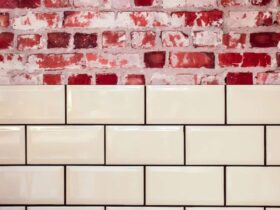The filling between bathroom tiles is typically grout, a cement-based mixture used to fill the gaps. Grout provides a durable and waterproof seal between the tiles, preventing water damage and mold growth.
It also enhances the aesthetic appeal of the tiled surface. When properly maintained, grout can last for many years, but it may require occasional cleaning and resealing to preserve its functionality and appearance. A well-installed and maintained grout not only ensures the longevity of your bathroom tiles but also contributes to a visually appealing and hygienic environment.
Understanding the importance of grout and how to care for it can help you maintain a beautiful and functional bathroom for years to come.
The Role Of Grout In Bathroom Tiling
When it comes to bathroom tiling, the filling between the tiles plays a crucial role in both protection and aesthetics. This filling, known as grout, not only helps to hold the tiles in place but also prevents water from seeping into the walls or floor. In addition to its functional purpose, grout also contributes to the overall appearance of the bathroom by enhancing the visual appeal of the tiles.
Grout Basics: Composition And Types
Grout is typically a mixture of cement, water, and sand. It is available in various types, each with its own unique properties and suitability for different applications. The most common types of grout used in bathroom tiling are:
- Sanded Grout: This type of grout contains sand, which provides strength and stability. It is recommended for wider tile joints, typically measuring more than 1/8 inch. Sanded grout is commonly used in areas with heavy foot traffic, such as bathroom floors.
- Unsanded Grout: Unlike sanded grout, unsanded grout does not contain sand. It is suitable for narrower tile joints, usually less than 1/8 inch wide. Unsanded grout is often used for wall tiles and in areas where there is minimal foot traffic.
- Epoxy Grout: Epoxy grout is a durable and stain-resistant option that is highly resistant to water and chemicals. It is commonly used in areas prone to moisture, such as showers and tub surrounds. Epoxy grout is available in a range of colors, allowing for more design flexibility.
Why Grout Matters: Protection And Aesthetics
Grout serves two essential purposes in bathroom tiling: protection and aesthetics.
Protection: The primary function of grout is to provide a protective barrier between tiles, preventing water from seeping through and causing damage to the underlying structure. Without grout, water could infiltrate the walls or floor, leading to mold, mildew, and potential structural issues.
Aesthetics: In addition to its protective role, grout also plays a significant role in enhancing the visual appeal of bathroom tiles. The color of the grout can complement or contrast with the tile color, allowing for creative design choices. The right choice of grout color can make a bathroom appear more spacious, highlight the pattern or texture of the tiles, and create a cohesive and harmonious overall look.
By understanding the basics of grout composition and types, as well as its importance in protection and aesthetics, you can make informed decisions when it comes to bathroom tiling. Whether you opt for sanded grout, unsanded grout, or epoxy grout, choosing the right grout for your specific application is crucial for both the longevity and visual impact of your bathroom tiles.
Selecting The Right Grout For Your Bathroom
When it comes to tiling your bathroom, selecting the right grout is just as important as choosing the perfect tiles. Grout not only fills the gaps between tiles but also plays a crucial role in ensuring the durability and longevity of your bathroom tiles. In this section, we will discuss the considerations for matching grout to your tiles and finding the perfect shade to enhance the overall look and feel of your bathroom.
Matching Grout To Tile: Considerations
When selecting grout for your bathroom tiles, there are a few important considerations to keep in mind. These considerations will help you achieve the desired aesthetic and functionality:
- Tile Size: The size of your tiles can influence the choice of grout. For smaller tiles, it is recommended to use unsanded grout, as it provides a smoother finish. Larger tiles may require sanded grout to fill the wider gaps between them.
- Tile Material: Different tile materials require different types of grout. For instance, natural stone tiles may need a specific type of grout that is compatible with their delicate surface.
- Tile Color and Texture: Consider the color and texture of your tiles when selecting grout. If your tiles have a bold or unique color, you may want to choose a grout that complements or contrasts with it to create a visually appealing effect.
- Location: The location of your tiles within the bathroom can also impact the grout choice. For areas exposed to high moisture, such as shower walls or bathroom floors, it is advisable to use epoxy grout, which provides better resistance to water and stains.
Color Choices: Finding The Perfect Shade
The color of the grout can significantly impact the overall appearance of your bathroom tiles. Here are some tips to help you find the perfect shade:
- Contrast or Match: Decide whether you want the grout color to contrast or blend with your tiles. Contrasting grout can create a bold and eye-catching effect, while matching grout can give a seamless and cohesive look.
- Consider Maintenance: Keep in mind that lighter grout colors may require more maintenance, as they can show dirt and stains more easily. Darker grout colors, on the other hand, may fade over time.
- Test Samples: Before making a final decision, obtain grout samples and place them next to your tiles to see how they look in different lighting conditions. This will help you visualize the end result and make an informed choice.
By considering these factors and selecting the right grout for your bathroom tiles, you can ensure a beautiful and long-lasting tiling job. Take your time to explore different options and consult with professionals if needed to make the best decision for your bathroom.
Application Techniques For Durable Grout Lines
For durable grout lines in bathroom tiles, proper application techniques are crucial. Grout is the filling material between tiles, enhancing their strength and longevity. Applying grout correctly ensures a long-lasting and aesthetically pleasing tile installation.
When it comes to bathroom tiles, the filling between the tiles is just as important as the tiles themselves. Grout not only fills in the gaps between tiles but also protects them from moisture, dirt, and debris. However, applying grout is not just a matter of filling in the gaps. It requires proper preparation and application techniques to ensure durable and long-lasting grout lines. In this post, we will discuss the best practices for preparing for grout application and applying grout for durable grout lines.
Preparing For Grout Application
Before you start applying grout, you need to prepare the tiles and the grout mixture. Here are some best practices for preparing for grout application:
- Clean the tiles thoroughly: Use a tile cleaner to remove any dirt, debris, or adhesive residue from the tiles. Make sure the tiles are completely dry before you start applying grout.
- Mix the grout: Follow the manufacturer’s instructions to mix the grout. Make sure the mixture is smooth and free of lumps.
- Let the mixture rest: Allow the grout mixture to rest for 5-10 minutes before applying it. This will ensure that the grout is evenly hydrated.
Best Practices For Applying Grout
Now that you have prepared for grout application, it’s time to apply the grout. Here are some best practices for applying grout:
- Work in small sections: It’s best to work in small sections of about 3-4 tiles at a time. This will allow you to apply the grout evenly before it dries out.
- Apply the grout diagonally: Use a rubber float to apply the grout diagonally across the tiles. This will help the grout fill in the gaps evenly.
- Remove excess grout: Use the rubber float to remove any excess grout from the tiles. Make sure you don’t remove too much grout from the gaps.
- Let the grout dry: Allow the grout to dry for about 15-20 minutes before cleaning the tiles.
- Clean the tiles: Use a damp sponge to clean the tiles and remove any grout haze. Rinse the sponge frequently to avoid spreading the grout haze.
By following these best practices for preparing for grout application and applying grout, you can ensure durable and long-lasting grout lines for your bathroom tiles. Remember to clean your tools and equipment after use to prolong their lifespan and ensure a smooth application process for your next tiling project.

Credit: www.reddit.com
Maintaining Your Grout: Tips And Tricks
When it comes to maintaining your bathroom tiles, taking care of the grout is essential for preserving the look and longevity of your tiled surfaces. Here are some valuable tips and tricks for keeping your grout in top condition.
Regular Cleaning For Longevity
Regular cleaning is key to ensuring the longevity of your grout. Use a gentle, pH-neutral cleaner to avoid damaging the grout. A mixture of water and vinegar can also be effective for removing surface dirt and grime without causing any harm to the grout.
Dealing With Mold And Mildew
Mold and mildew are common issues in bathroom grout due to the moisture-rich environment. Regularly inspect the grout for any signs of mold or mildew. If you spot any, use a solution of bleach and water or a commercial anti-fungal cleaner to tackle the problem.
Repairing Grout In Bathroom Tiles
The grout between bathroom tiles often needs repairing to maintain a clean and polished look. Over time, grout can deteriorate, crack, or discolor, affecting the overall appearance of the tiles. Regular maintenance and timely repairs are essential to prevent water damage and keep the bathroom looking fresh and well-maintained.
Identifying When Grout Needs Repair
Grout is the material used to fill the gaps between bathroom tiles, and it is essential for maintaining the durability and appearance of the tiled surface. Over time, grout can deteriorate due to water exposure, mold growth, and general wear and tear. Identifying when grout needs repair is crucial to prevent water damage and preserve the aesthetic appeal of your bathroom. Inspect the grout lines for signs of discoloration, cracking, or crumbling to determine if repair is necessary. Additionally, if there are areas where grout is completely missing, it’s a clear indication that repair is needed.
Step-by-Step Grout Replacement
When it comes to repairing grout in bathroom tiles, a step-by-step approach can ensure a successful restoration of the tiled surface. Follow these clear instructions to replace grout effectively:
1. Gather the necessary tools and materials, including grout saw, grout, grout float, and sponge.
2. Carefully remove the damaged grout using a grout saw, taking care not to damage the tiles.
3. Prepare the new grout mixture according to the manufacturer’s instructions.
4. Apply the new grout into the spaces between the tiles using a grout float, ensuring it is evenly distributed.
5. Clean off any excess grout from the tile surface with a damp sponge.
6. Allow the grout to cure as per the recommended time frame, typically 24-72 hours.
7. Finally, apply a grout sealer to protect the new grout and prevent future damage.
By following these steps, you can effectively repair the grout in your bathroom tiles, ensuring a long-lasting and visually appealing result.
Innovative Grout Alternatives And Enhancements
When it comes to the filling between bathroom tiles, traditional grout has long been the go-to option. However, there are now innovative alternatives and enhancements available that offer improved durability, protection, and aesthetic appeal. In this article, we will explore two popular options: epoxy and other grout alternatives, as well as sealants and additives for extra protection.
Epoxy And Other Grout Alternatives
Epoxy grout is a top choice for those seeking a more durable and stain-resistant option. Unlike traditional grout, epoxy grout is made from a combination of epoxy resin and filler materials, resulting in a stronger and more waterproof solution. This type of grout is particularly suitable for high-moisture areas, such as bathrooms, where water and humidity can lead to mold and mildew growth.
Another alternative to consider is urethane grout. This type of grout is made from a combination of polymers, pigments, and fillers, offering similar benefits to epoxy grout. Urethane grout is known for its flexibility, making it less prone to cracking and breaking. Additionally, it is resistant to stains and chemicals, making it easier to clean and maintain.
For those looking for a more natural option, there are cement-based grouts available. These grouts are made from a mixture of cement, sand, and additives. While not as durable or stain-resistant as epoxy or urethane grouts, cement-based grouts offer a more traditional look and feel. They are also easier to work with and can be a cost-effective choice for smaller projects.
Sealants And Additives For Extra Protection
In addition to exploring alternative grout options, it’s important to consider sealants and additives that can enhance the durability and protection of your bathroom tile installation. These products can help prevent water penetration, reduce staining, and increase the lifespan of your grout.
One popular choice is a silicone-based grout sealer. This type of sealer creates a protective barrier that repels water and stains, keeping your grout looking clean and fresh. It is easy to apply and can be used on various types of grout.
Another option is to use grout additives, such as antimicrobial agents or color enhancers. Antimicrobial additives help inhibit the growth of mold, mildew, and bacteria, ensuring a cleaner and healthier bathroom environment. Color enhancers, on the other hand, can revitalize the appearance of your grout, making it look vibrant and new.
By considering these innovative grout alternatives and enhancements, you can achieve a bathroom tile installation that not only looks great but also offers improved durability and protection. Whether you opt for epoxy grout, urethane grout, or cement-based grout, don’t forget to explore sealants and additives that can further enhance the performance and aesthetics of your bathroom tiles.
Frequently Asked Questions
What Type Of Material Is Used For Filling Between Bathroom Tiles?
The filling between bathroom tiles is typically grout, a cement-based mixture that fills gaps.
How Often Should The Filling Between Bathroom Tiles Be Replaced?
It is recommended to replace the filling between bathroom tiles every 2-3 years for upkeep.
Can You Repair The Filling Between Bathroom Tiles Yourself?
Yes, you can repair the filling between bathroom tiles yourself using grout and proper tools.
What Are The Consequences Of Leaving Damaged Filling Between Bathroom Tiles?
Leaving damaged filling between bathroom tiles can lead to water seepage and mold growth.
Is It Necessary To Seal The Filling Between Bathroom Tiles?
Sealing the filling between bathroom tiles is crucial to prevent water damage and maintain cleanliness.
How Can One Prevent Staining Of The Filling Between Bathroom Tiles?
Regular cleaning and sealing can help prevent staining of the filling between bathroom tiles.
Conclusion
To sum it up, the filling between bathroom tiles plays a crucial role in maintaining the overall aesthetics and hygiene of your bathroom. It prevents the growth of mold and mildew, which can be harmful to your health. Choosing the right type of filler and maintaining it regularly can help prolong the life of your tiles and keep your bathroom looking fresh and clean.
With the right knowledge and tools, you can easily fix any issues with the filling and enjoy a beautiful bathroom for years to come.









Leave a Reply